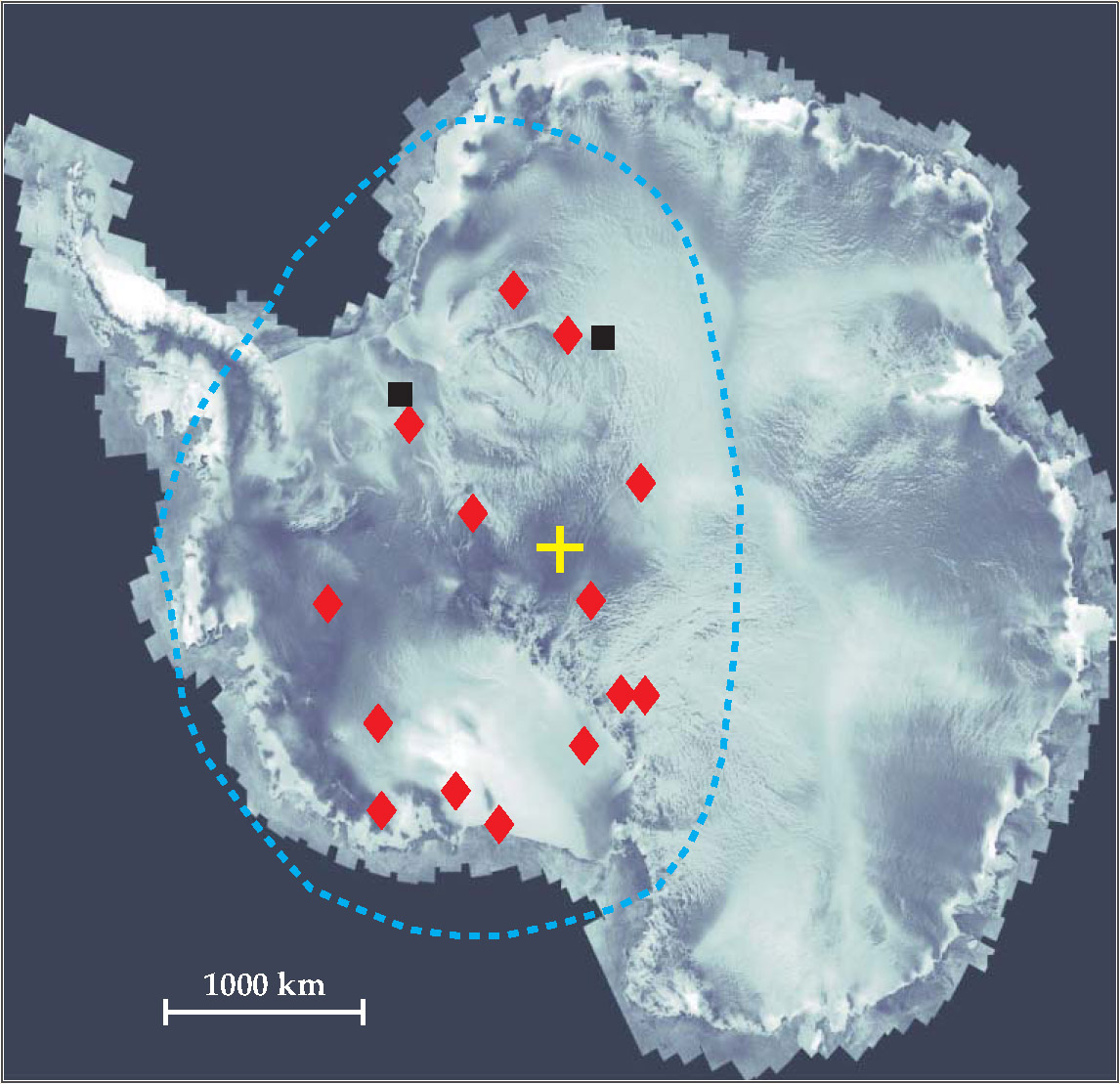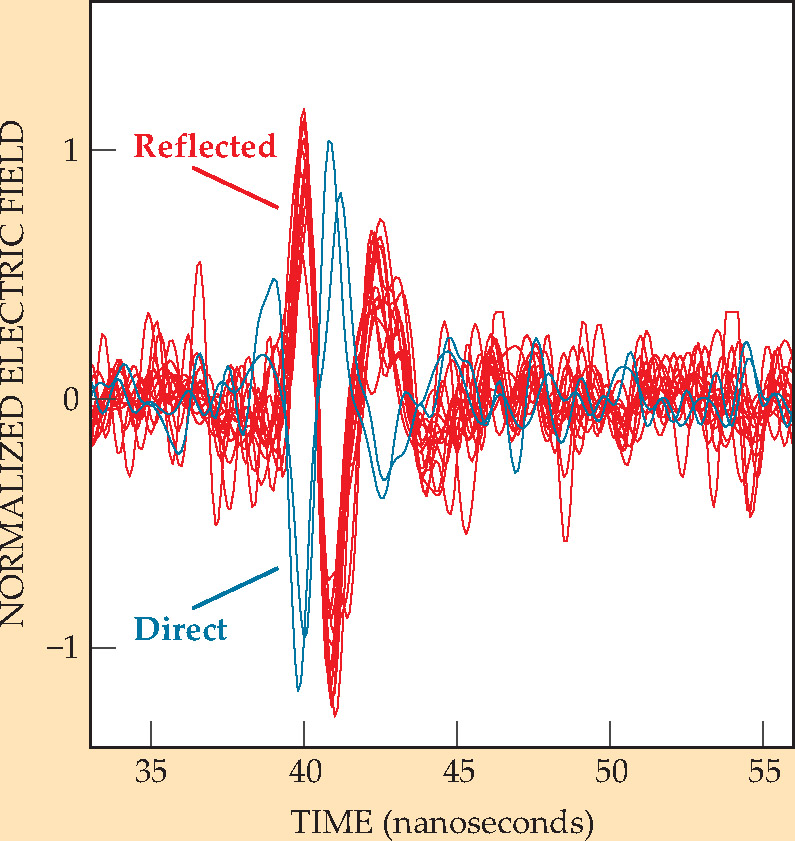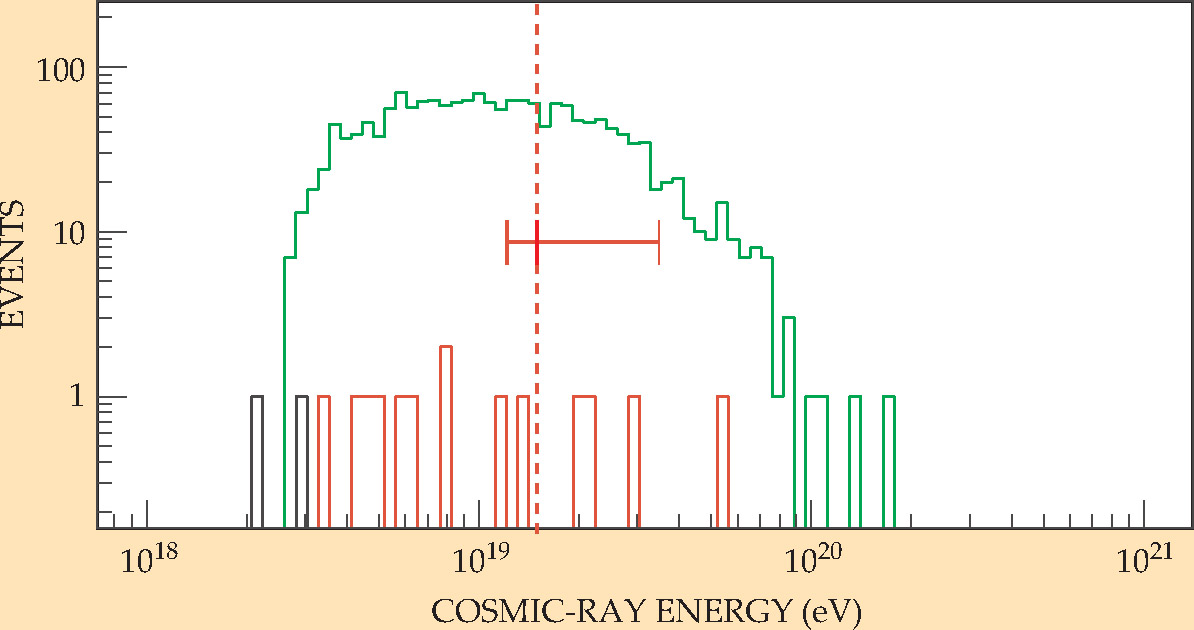Balloon experiment reveals a new way of finding ultrahigh-energy cosmic rays
DOI: 10.1063/1.3529397
Ultrahigh-energy cosmic rays (UHECRs), with energies exceeding 1019 eV, are almost certainly of extra-galactic origin. But decades of observation with large ground arrays of particle detectors and fluorescence telescopes have yet to yield statistically robust evidence of anisotropic arrival that might reveal their sources (see Physics Today, May 2010, page 15
The observer’s chief problem is their scarcity. Above 1020 eV, a CR proton, negligibly deflected by intergalactic magnetic fields, should reliably point back toward its source. But less than one per century strikes a random square kilometer of Earth. The Pierre Auger Observatory in Argentina, the largest of the ground arrays, covers only 3000 km2.
But now a serendipitous observation by the ANITA (Antarctic Impulsive Transient Antenna) collaboration’s balloon-borne radio-pulse detector array holds out the prospect of monitoring millions of square kilometers for UHECR strikes with comparative ease—albeit with an acceptance solid angle significantly smaller than those of the ground arrays. 1 The collaboration, headed by Peter Gorham (University of Hawaii), had designed ANITA to monitor Antarctica from above for the nanosecond radio pulses expected from the interaction of high-energy cosmogenic neutrinos with nuclei in the ice.
In three weeks of riding the circumpolar stratospheric wind, ANITA found no evidence of the expected high-energy neutrinos. But what it did find was both unexpected and promising. Recording all detectable nanosecond pulses in the RF band 200-1000 MHz, the detector accumulated 16 pulses whose polarization and phase characteristics convincingly marked them as originating in distant charged-particle showers instigated in the atmosphere by UHECRs.
Why unexpected? It was understood that a high-energy CR shower can launch a coherent nanosecond RF pulse along its axis, and indeed such pulses had been studied with radio detectors close to the showers at ground arrays. The radio data came from CRs well below 1019 eV, at wavelengths too long to be useful for balloon-borne radio interferometry. Pulse intensity does grow as the square of the CR’s energy. But extrapolation of those results to higher energies and shorter wavelengths seemed to show that even a radio pulse from a 1020 eV CR would be too weak for useful surveillance at a large distance from the air shower that launched it. “Extrapolating such near-field radiation data is difficult,” cautions Gorham. “And the ANITA observation will doubtless send the extrapolators back to their pencil sharpeners.”
The detector
The ANITA detector has 40 antenna horns arrayed around the balloon’s gondola. They measure a pulse’s polarization and, by interferometry, its incident direction to within about 2°. Because the bulk of the continental area under surveillance is far out toward the horizon, one expects most recorded incident directions to be nearly horizontal.
A pulse’s polarization is crucial to distinguishing between neutrino and CR origin. A high-energy neutrino traversing the ice could produce a detectible radio pulse by generating a shower of charged particles whose radio-Cherenkov radiation breaks out of the ice. Given the optical properties of the ice-air interface, the polarization of such pulses would be mostly vertical. By contrast, the radio pulse from a CR shower is due to synchrotron radiation from shower electrons and positrons spiraling around geomagnetic field lines. The geosynchrotron radiation is polarized in the plane normal to the magnetic field. And because the field in Antarctica is largely vertical, the polarizations of UHECR pulses should be mostly horizontal.
All 16 candidate events had essentially horizontal polarization. But that’s only the beginning of the evidence for their UHECR origins. They all arrived at the 37-km-high balloon from directions slightly below the horizontal. Extrapolating those directions back down, the analysis team found that 14 of them pointed back to distant points on the continent (shown red in figure 1) where, presumably, pulses generated by UHECRs that entered the atmosphere at glancing angles were reflected off the ice. The other 2 appear to have entered the atmosphere at such extreme glancing angles that their pulses went straight to ANITA without a bounce. The two black squares in the figure are estimates of where those UHECRs generated air showers.

Figure 1. On a radar map of Antarctica are marked the 14 locations (red diamonds) at which radio pulses generated by air showers from ultrahigh-energy cosmic rays were deduced to have been reflected off the ice and into the balloon-borne ANITA detector. The 2 black squares mark the estimated locations of the cosmic-ray showers that launched radio pulses directly at ANITA without reflection. The cross marks the South Pole and the dashed loop is ANITA’s viewing horizon.
(Adapted from

The CR interpretation is strengthened by comparing the pulse shapes of the 14 reflected and 2 direct radio pulses in figure 2. They’re all similar. But as one would expect, mirror reflection inverts the phases of the 14. Another confirmation comes from the slight variation of the geomagnetic field’s inclination across the continent. Noting the field’s precise direction at each putative shower location, the team found that pulse polarization varied with field direction just as expected for geosynchrotron radiation.

Figure 2. Shapes of the 16 radio pulses recorded by the ANITA detector and attributed to ultrahigh-energy cosmic rays. Each pulse rises above background for just a few nanoseconds. The dominant RF component is about 300 MHz. The sign of the oscillating electric field is defined in terms of a cross product between the pulse’s propagation vector and the geomagnetic field. The pulses reflected off the Antarctic ice (red curves) differ by a 180° phase inversion from those that reached the detector directly (blue).
(Adapted from

Energy and celestial direction
The 16 events were randomly distributed over ANITA’s field of view, uncorrelated with human activity that might create unrecognized artifacts. Ultimately, of course, one is more interested in the incident celestial direction of a UHECR—and its energy—than in where its radio pulse bounced off the ice. To that end, the team availed itself of radar maps of local slopes and reflection properties of the continental ice cover. The reflections, they concluded, were mostly specular (mirrorlike) rather than diffuse.
Local surface properties were also considered in estimating each incident CR’s energy from the pulse’s amplitude, travel distance, RF spectrum, and other properties. Figure 3 shows the distribution of energies thus determined. The mean estimated energy is 1.5 × 1019 eV, but the error on the mean is large and asymmetric. The asymmetry, implying that underestimates are more likely than overestimates, comes largely from the fact that a radio pulse of finite lateral width reflects off the ice over an extended elliptical blotch, and the detector is likely to be seeing the reflection from a relatively faint, off-center spot on that ellipse.

Figure 3. Energy distribution of the 16 ultrahigh-energy cosmic rays presumed to have generated the radio pulses recorded by ANITA. The 14 events reflected off the Antarctic ice are shown red; the two observed directly are shown black. (Wider bins indicate several events.) The dashed line and its error bar indicate the overall ANITA sample’s mean energy and the asymmetric uncertainty of that mean. The green histogram is a simulation, based on the known cosmic-ray spectrum, of what ANITA could expect to record in a very long exposure.
(Adapted from

“At this early stage, our energy resolution is still far from the impressive 15% achieved by the ground detectors and fluorescence telescopes,” says Gorham. “But they’ve been refining their calibrations for decades.” Energy resolution is particularly important in the region around 5 × 1019 eV, the threshold for pion production by CR protons scattering off the cosmic microwave background (the Greisen-Zatsepin-Kuzmin, or GZK, effect).
Only above 1020 eV are CR proton trajectories magnetically rigid enough to travel cosmological distances without significant deflection. But, in a kind of catch-22, the GZK effect prevents a CR proton from persisting more than a few hundred million light-years above 5 × 1019 eV. That, in fact, is why observers have been searching urgently for ultrahigh-energy neutrinos from the decay of very distant GZK pions. Neutrinos are impervious not only to magnetic fields but also to the microwave background.
The relationship between ultrahigh-energy neutrinos and UHECRs is somewhat incestuous. The fact that the expected GZK neutrinos have not yet been detected by ANITA
2
or by the enormous subsurface IceCube detector (see the article by Francis Halzen and Spencer Klein, Physics Today, May 2008, page 29
ANITA’s 2° pointing acuity, unlike its energy resolution, is already competitive with that of the ground arrays. “Our next flight, with the detector optimized for cosmic rays as well as neutrinos, should harvest several hundred UHECRs,” says Gorham.
But ANITA can fly only a few weeks a year, in the austral summer. So, for radio detection to compete with the year-round UHECR collecting rates of the ground arrays, Gorham envisions balloon- or satellite-borne detectors monitoring the open oceans as well as the polar ice for reflected UHECR radio pulses.
References
1. S. Hoover et al., Phys. Rev. Lett. 105, 151101 (2010). https://doi.org/10.1103/PhysRevLett.105.151101
2. P. W. Gorham et al., Phys. Rev. D 82, 022004 (2010). https://doi.org/10.1103/PhysRevD.82.022004




